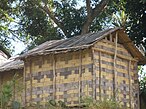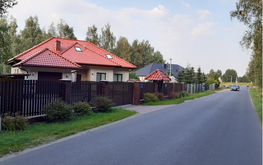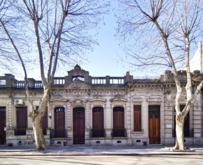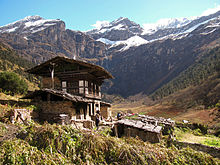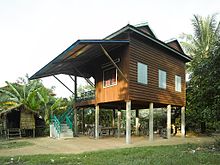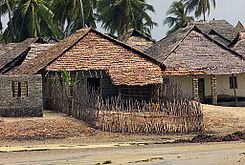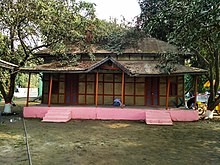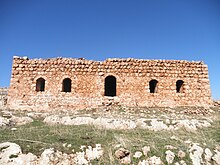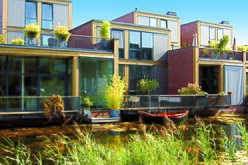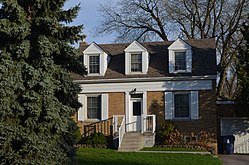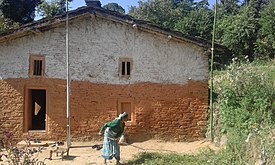House
| Part of a series on |
| Living spaces |
|---|
 |
A house is a single-unit residential
The social unit that lives in a house is known as a
Etymology

The English word
Elements
Layout
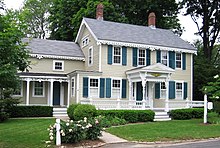
Ideally, architects of houses design rooms to meet the needs of the people who will live in the house. Feng shui, originally a Chinese method of moving houses according to such factors as rain and micro-climates, has recently expanded its scope to address the design of interior spaces, with a view to promoting harmonious effects on the people living inside the house, although no actual effect has ever been demonstrated. Feng shui can also mean the "aura" in or around a dwelling, making it comparable to the real estate sales concept of "indoor-outdoor flow".
The

Humans often build houses for domestic or
.Parts
Many houses have several large rooms with specialized functions and several very small rooms for other various reasons. These may include a living/eating area, a sleeping area, and (if suitable facilities and services exist) separate or combined washing and lavatory areas. Some larger properties may also feature rooms such as a spa room, indoor pool, indoor basketball court, and other 'non-essential' facilities. In traditional agriculture-oriented societies, domestic animals such as chickens or larger livestock often share part of the house with humans. Most conventional modern houses will at least contain a bedroom, bathroom, kitchen or cooking area, and a living room. The names of parts of a house often echo the names of parts of other buildings, but could typically include:
- Alcove
- Atrium
- Attic
- Basement/cellar
- Bathroom
- Bedroom (or nursery)
- Box-room/ storage room
- Conservatory
- Dining room
- Family room or den
- Fireplace
- Foyer
- Front room
- Garage
- Hallway / passage / Vestibule
- Hearth
- Home-office or study
- Kitchen
- Larder
- Laundry room
- Library
- Living room
- Loft
- Nook
- Pantry
- Parlour
- Porch
- rumpus room / televisionroom
- Shrines to serve the religious functions associated with a family
- Stairwell
- Sunroom
- Swimming pool
- Window
- Workshop
History


Little is known about the earliest origin of the house and its interior; however, it can be traced back to the simplest form of shelters. An exceptionally well-preserved house dating to the fifth millennium BC and with its contents still preserved was for example excavated at
As far as the idea of the home is concerned, the home of the home is the Netherlands. This idea's crystallization might be dated to the first three-quarters of the 17th century, when the Dutch Netherlands amassed the unprecedented and unrivalled accumulation of capital, and emptied their purses into domestic space.[10]
Middle Ages
In the
During the 15th and 16th centuries, the
- "Once inside it is necessary to pass from one room to the next, then to the next to traverse the building. Where passages and staircases are used, as inevitably they are, they nearly always connect just one space to another and never serve as general distributors of movement. Thus, despite the precise architectural containment offered by the addition of room upon room, the villa was, in terms of occupation, an open plan, relatively permeable to the numerous members of the household."[12] Although very public, the open plan encouraged sociality and connectivity for all inhabitants.[9]
An early example of the segregation of rooms and consequent enhancement of privacy may be found in 1597 at the
Sociologist Witold Rybczynski wrote, "the subdivision of the house into day and night uses, and into formal and informal areas, had begun."[15] Rooms were changed from public to private as single entryways forced notions of entering a room with a specific purpose.[9]
Industrial Revolution
Compared to the large scaled houses in England and the Renaissance, the
By the end of the 17th century, the house layout was transformed to become employment-free, enforcing these ideas for the future. This came in favour for the

19th and 20th centuries
In the American context, some professions, such as doctors, in the 19th and early 20th century typically operated out of the front room or parlor or had a two-room office on their property, which was detached from the house. By the mid 20th century, the increase in high-tech equipment created a marked shift whereby the contemporary doctor typically worked from an office or hospital.[16][17]
Technology and electronic systems has caused privacy issues and issues with segregating personal life from remote work. Technological advances of surveillance and communications allow insight of personal habits and private lives.[9] As a result, the "private becomes ever more public, [and] the desire for a protective home life increases, fuelled by the very media that undermine it," writes Jonathan Hill.[9] Work has been altered by the increase of communications. The "deluge of information"[9] has expressed the efforts of work conveniently gaining access inside the house. Although commuting is reduced, the desire to separate working and living remains apparent.[9] On the other hand, some architects have designed homes in which eating, working and living are brought together.
Gallery
-
Modern land house in Germany
-
Modern suburban house in Poland
-
Farmhouse in Bhutan
-
Khmer house in Cambodia
-
Traditional house in Colombia
-
Minangkabau traditional house in Indonesia
-
Traditional village house in Banaue, Philippines
-
House in Brgule, Serbia
-
Traditional house in Japan
-
Traditional two-story tin shed house in Bangladesh
-
Traditional stone house in Serbia
-
A traditional Kurdish stone house
-
Energy-efficient houses in Amersfoort, Netherlands
-
A house in Ontario, Canada
-
A decorated house in Utrecht, Netherlands
-
A single living house in Addis Ababa, Ethiopia
-
Old and new houses side by side in Dallas
-
Traditional house in Darchula District Nepal
-
A standard house in Ghana
Construction
In many parts of the world, houses are constructed using scavenged materials. In Manila's Payatas neighborhood, slum houses are often made of material sourced from a nearby garbage dump.[18] In Dakar, it is common to see houses made of recycled materials standing atop a mixture of garbage and sand which serves as a foundation. The garbage-sand mixture is also used to protect the house from flooding.[19]


These homes are often illegally built and without electricity, proper sanitation and taps for drinking water.
In the United States, modern house construction techniques include light-frame construction (in areas with access to supplies of wood) and adobe or sometimes rammed-earth construction (in arid regions with scarce wood-resources). Some areas use brick almost exclusively, and quarried stone has long provided foundations and walls. To some extent, aluminum and steel have displaced some traditional building materials. Increasingly popular alternative construction materials include insulating concrete forms (foam forms filled with concrete), structural insulated panels (foam panels faced with oriented strand board or fiber cement), light-gauge steel, and steel framing. More generally, people often build houses out of the nearest available material, and often tradition or culture govern construction-materials, so whole towns, areas, counties or even states/countries may be built out of one main type of material. For example, a large portion of American houses use wood, while most British and many European houses use stone, brick, or mud.
In the early 20th century, some house designers started using
Lesser-used construction methods have gained (or regained) popularity in recent years. Though not in wide use, these methods frequently appeal to homeowners who may become actively involved in the construction process. They include:
- Hempcrete construction
- Cordwood construction
- Geodesic domes
- Straw-bale construction
- Wattle and daub
- Timber framing
- Framing (construction)
In the developed world,
Development of a number of
Legal issues

Buildings with historical importance have legal restrictions. New houses in the UK are not covered by the
Identification and symbolism
With the growth of dense settlement, humans designed ways of identifying houses and
Houses may express the circumstances or opinions of their builders or their inhabitants. Thus, a vast and elaborate house may serve as a sign of conspicuous wealth whereas a low-profile house built of recycled materials may indicate support of energy conservation. Houses of particular historical significance (former residences of the famous, for example, or even just very old houses) may gain a protected status in
See also
Building
- House-building
- Index of construction articles
Functions
Types
- Boarding house
- Earth sheltering
- Home automation
- Housing estate
- Housing in Japan
- Hurricane-proof house
- Lodging
- Lustron house
- Mobile home
- Modular home
- Slope house
- Summer house
- Tiny house
Economics
- Affordable housing
- Real estate bubble
- United States housing bubble
- Housing tenure
- Show house
Miscellaneous
Institutions
- U.S. Department of Housing and Urban Development
Lists
- List of American houses
- List of house styles
- List of house types
- List of real estate topics
- Open-air museum
References
- ^ Schoenauer, Norbert (2000). 6,000 Years of Housing (rev. ed.) (New York: W.W. Norton & Company).
- ^ "housing papers" (PDF). clerk.house.gov. Archived from the original (PDF) on January 17, 2013. Retrieved December 18, 2012.
- ^ "Online Etymology Dictionary". Etymonline.com. Retrieved January 4, 2012.
- ISBN 0-7679-1173-3.
- ^ Grima, Noel (July 24, 2017). "The Book That Came Back from Death." Independent.com.mt. Retrieved April 29, 2020.
- ^ http://melitensiawth.nl/index/Journal%20of%20Maltese%20Studies/JMS.16.1986/02s.pdf [dead link]
- ISBN 978-9380228488.
- OCLC 10923961.
- ^ a b c d e f g h i j k Hill, Jonathan, "Immaterial Architecture", New York: Routledge, 2006.
- ^ Tabor, Philip, "Striking Home: The Telematic Assault on Identity". Published in Jonathan Hill, editor, Occupying Architecture: Between the Architect and the User.
- ^ "Manor House". Middle-ages.org.uk. May 16, 2007. Archived from the original on September 6, 2012. Retrieved January 4, 2012.
- ^ a b Evans, Robin "Translations from Drawing to Building: Figures, Doors and Passages" London: Architectural Associations Publications 2005
- ^ Summerson, John "The Book Of Architecture of John Thorpe in Sir John Soane's museum: 40th Volume of the Walpole Society" England: The Society 1964
- ^ a b Pratt, Sir Roger "Sir R. Pratt on Architecture" 1928
- ISBN 0-14-010231-0.
- ^ "Doctor's and Dentist's Offices". Melnick Medical Museum. January 29, 2009. Retrieved June 12, 2018.
- ^ "Doctor's residence and surgery, No 8 Milford Ave, Randwick, New South Wales, photograph taken by Sam Hood for LJ Hooker", State Library of New South Wales, Home and Away 11690, FL1472550, 1951. Retrieved 14 November 2018.
- ^ Brown, Andy (2009). "Below the poverty line: living on a garbage dump". Real Lives. UNICEF. Archived from the original on January 7, 2019. Retrieved July 12, 2013.
Slum houses, often made of materials scavenged from the dump site...
- ^ Nossiter, Adam (May 2, 2009). "In Senegal, Building on Perilous Layers of Trash". The New York Times.
- ^ "Energy Performance Certificates – what they are : Directgov – Home and community". Direct.gov.uk. Retrieved January 4, 2012.
External links
- Housing through the centuries, animation by The Atlantic







